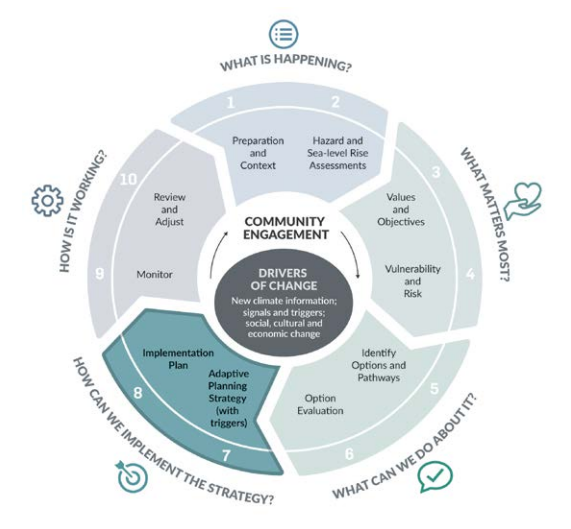Implementation plan (MfE Step 8)
With the adoption of the CAPs by Council, the next stage is the development of an implementation plan for consultation via the Thames-Coromandel 2024-2034 Long Term Plan (Step 8 as shown in the figure below).

This will involve prioritising locations where short (and medium) term actions need to be taken, as well as locations where further information is required (e.g., locations where the pathway should be informed by a combined assessment of coastal and river flooding). The prioritisation process to be undertaken will provide for the allocation of funds and resources for any actions.
Short term actions are likely to include:
-
Embedding the outcomes of the project across TCDC, including asset management planning and civil defence.
-
Forward planning and growth of the coastal restoration programme.
-
Progressing global consents (e.g., for multiple sediment recycling proposals on the west coast and push-ups on the east coast).
-
Progressing a plan change to include inundation hazard zones and limits on inappropriate development (development that is not adapted or flexible) and subdivision in hazard zones.
-
Including greater flexibility in the planning process to enable resilience (e.g., where the pathway advocates raising floor levels, the planning consents associated with this should be simple to obtain).
-
Combined river and coastal flood modelling in priority locations.
-
Development of a monitoring programme (to measure and track signals and triggers).
-
The identification and pursuit of funding opportunities (for example, for the detailed design for urgent protection initiatives).
This will require ongoing collaboration and advocacy involving:
-
The community
-
Pare Hauraki and local iwi.
-
WRC and Regional Planning Committees.
-
Waka Kotahi.
-
The Ministry of Education and others.
In taking next steps, TCDC is aware of developing central government policy relating to adaptation planning, including current RMA reforms (specifically the ‘Climate Change and Managed Retreat Act’) and National Adaptation Plan. Noting that TCDC have already met several of the recommendations for the development of community adaption plans (e.g., supporting communities to consider a range of adaptation options and ensuring climate-resilient development occurs in the right places).
It is recommended that ways are sought to build on the engagement and good will of the Coastal Panels as part of the implementation plan, through ongoing collaboration. This could, for example, be realised through community action groups.